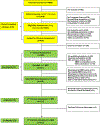Evaluating the Evidence for Brain-Based Biotypes of Psychiatric Vulnerability in the Acute Aftermath of Trauma
- PMID: 36628514
- PMCID: PMC9898083
- DOI: 10.1176/appi.ajp.20220271
Evaluating the Evidence for Brain-Based Biotypes of Psychiatric Vulnerability in the Acute Aftermath of Trauma
Abstract
Objective: The weak link between subjective symptom-based diagnostic methods for posttraumatic psychopathology and objectively measured neurobiological indices forms a barrier to the development of effective personalized treatments. To overcome this problem, recent studies have aimed to stratify psychiatric disorders by identifying consistent subgroups based on objective neural markers. Along these lines, a promising 2021 study by Stevens et al. identified distinct brain-based biotypes associated with different longitudinal patterns of posttraumatic symptoms. Here, the authors conducted a conceptual nonexact replication of that study using a comparable data set from a multimodal longitudinal study of recent trauma survivors.
Methods: A total of 130 participants (mean age, 33.61 years, SD=11.21; 48% women) admitted to a general hospital emergency department following trauma exposure underwent demographic, clinical, and neuroimaging assessments 1, 6, and 14 months after trauma. All analyses followed the pipeline outlined in the original study and were conducted in collaboration with its authors.
Results: Task-based functional MRI conducted 1 month posttrauma was used to identify four clusters of individuals based on profiles of neural activity reflecting threat and reward reactivity. These clusters were not identical to the previously identified brain-based biotypes and were not associated with prospective symptoms of posttraumatic psychopathology.
Conclusions: Overall, these findings suggest that the original brain-based biotypes of trauma resilience and psychopathology may not generalize to other populations. Thus, caution is warranted when attempting to define subtypes of psychiatric vulnerability using neural indices before treatment implications can be fully realized. Additional replication studies are needed to identify more stable and generalizable neuroimaging-based biotypes of posttraumatic psychopathology.
Trial registration: ClinicalTrials.gov NCT03756545.
Keywords: Biological Markers; Neuroimaging; Neuroscience; Posttraumatic Stress Disorder (PTSD); Replication Study; Stress.
Figures



Similar articles
-
Neuroimaging of posttraumatic stress disorder in adults and youth: progress over the last decade on three leading questions of the field.Mol Psychiatry. 2024 Oct;29(10):3223-3244. doi: 10.1038/s41380-024-02558-w. Epub 2024 Apr 17. Mol Psychiatry. 2024. PMID: 38632413 Free PMC article. Review.
-
Brain-Based Biotypes of Psychiatric Vulnerability in the Acute Aftermath of Trauma.Am J Psychiatry. 2021 Nov;178(11):1037-1049. doi: 10.1176/appi.ajp.2021.20101526. Epub 2021 Oct 14. Am J Psychiatry. 2021. PMID: 34645277 Free PMC article.
-
The Role of the Hippocampus in Predicting Future Posttraumatic Stress Disorder Symptoms in Recently Traumatized Civilians.Biol Psychiatry. 2018 Jul 15;84(2):106-115. doi: 10.1016/j.biopsych.2017.09.005. Epub 2017 Sep 20. Biol Psychiatry. 2018. PMID: 29110899 Free PMC article.
-
Persistent Dissociation and Its Neural Correlates in Predicting Outcomes After Trauma Exposure.Am J Psychiatry. 2022 Sep;179(9):661-672. doi: 10.1176/appi.ajp.21090911. Epub 2022 Jun 22. Am J Psychiatry. 2022. PMID: 35730162 Free PMC article.
-
[Posttraumatic stress disorder (PTSD) as a consequence of the interaction between an individual genetic susceptibility, a traumatogenic event and a social context].Encephale. 2012 Oct;38(5):373-80. doi: 10.1016/j.encep.2011.12.003. Epub 2012 Jan 24. Encephale. 2012. PMID: 23062450 Review. French.
Cited by
-
Neuroimaging of posttraumatic stress disorder in adults and youth: progress over the last decade on three leading questions of the field.Mol Psychiatry. 2024 Oct;29(10):3223-3244. doi: 10.1038/s41380-024-02558-w. Epub 2024 Apr 17. Mol Psychiatry. 2024. PMID: 38632413 Free PMC article. Review.
-
Neuroimaging-based variability in subtyping biomarkers for psychiatric heterogeneity.Mol Psychiatry. 2025 May;30(5):1966-1975. doi: 10.1038/s41380-024-02807-y. Epub 2024 Nov 7. Mol Psychiatry. 2025. PMID: 39511450 Free PMC article.
-
Amygdala Structure and Function: Association With Transdiagnostic Trauma Severity in Anxiety and Mood Disorder Patients.Psychophysiology. 2025 Mar;62(3):e70027. doi: 10.1111/psyp.70027. Psychophysiology. 2025. PMID: 40071850
-
Structural Neuroimaging of Hippocampus and Amygdala Subregions in Posttraumatic Stress Disorder: A Scoping Review.Biol Psychiatry Glob Open Sci. 2023 Jul 13;4(1):120-134. doi: 10.1016/j.bpsgos.2023.07.001. eCollection 2024 Jan. Biol Psychiatry Glob Open Sci. 2023. PMID: 38298789 Free PMC article.
-
Aberrant connectivity in the right amygdala and right middle temporal gyrus before and after a suicide attempt: Examining markers of suicide risk.J Affect Disord. 2023 Aug 15;335:24-35. doi: 10.1016/j.jad.2023.04.061. Epub 2023 Apr 21. J Affect Disord. 2023. PMID: 37086805 Free PMC article.
References
-
- Marquand AF, Wolfers T, Mennes M, Buitelaar J, Beckmann CF. Beyond Lumping and Splitting: A Review of Computational Approaches for Stratifying Psychiatric Disorders. Biological Psychiatry: Cognitive Neuroscience and Neuroimaging. 2016;1(5):433–447. doi:10.1016/j.bpsc.2016.04.002 - DOI - PMC - PubMed
-
- Maron-Katz A, Zhang Y, Narayan M, et al. Individual Patterns of Abnormality in RestingState Functional Connectivity Reveal Two Data-Driven PTSD Subgroups. American Journal of Psychiatrysychiatry. 2020;177(3):244–253. doi:10.1176/APPI.AJP.2019.19010060/ASSET/IMAGES/LARGE/APPI.AJP.2019.19010060F4.JPEG - DOI - PubMed
Publication types
MeSH terms
Associated data
Grants and funding
LinkOut - more resources
Full Text Sources
Medical

